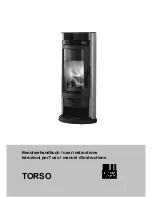
57
4
the stove is designed for normal operation with closed charging door. the safe
operation and optimal efficiency can only be reached with a closed charging door.
keeping the charging door closed will also prevent burning or hot particles from
leaving the stove.
D.3 REqUiREMEnTs TO ThE FUEL
•
Only use firewood and its derivates such as wood coal or compressed saw-
dust with less than 20% moisture content. Do not use fresh, recently chop-
ped wood. Not properly dried wood will cause creosote, more soot, more
pollution and result in lower efficiency. Wood is considered to be dry when
stored for a minimum of 2 years in a dry, well ventilated environment.
•
Use firewood of max. 25-28 cm. length and a diameter of maximum 20 cm.
•
To protect the environment and the complete stove system, do not use:
- wood work scraps with glues and/or solvents, - waste wood in general,
- cardboard (for start up purposes a minimum of paper may be used only
during the starting phase), -painted or impregnated wood, -bonded wood
(such chipboard, hardboard, MDF), synthetic fibers.
•
Do not use liquid fuel, alcohol, petrol, gasoline etc.
•
Do not use the stove as a burner for waste materials.
D.4 ROOM AiR ciRcULATiOn
this stove is provided with a room air circulation fan. When the fan is switched on
the room air is drawn across the internal hot surfaces of the stove and due to this
warmed up.
The room air circulation fan is on/off controlled by the room air circulation switch,
see picture 4. When the room air circulation fan is switched off the wood load (fire)
must be kept to a minimum.
G
the performance of the stove is best using strong, harder wood such as
oak, beech, ash and elm. soft woods like pine tree, poplar and linden will
result in less performance and possible more residue and soot.
Picture 4:
room air circulation switch
man_Arabella ('09).indd 57
02-09-2009 08:49:42
Содержание ARBELLA
Страница 17: ...65 4...




































